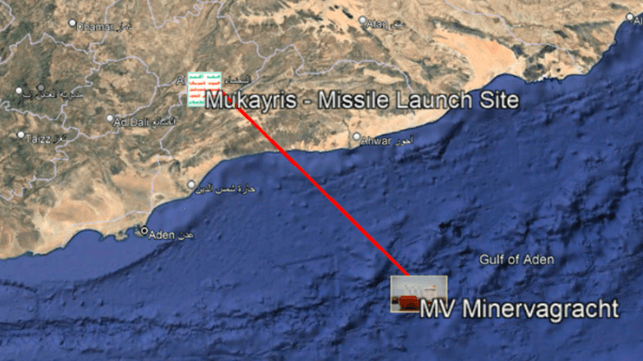Houthi Anti-Ship Missiles are Positioned to Cover the Gulf of Aden

On September 29, the Houthis mounted an attack on the Dutch-flagged 9,524GT general cargo vessel MV Minervagracht (IMO 9571521). The ship is owned by the Dutch firm Spliethoff, which operates a fleet of over 50 Dutch-flagged multipurpose vessels. The UKMTO reported that after an earlier attack missed, the ship was subsequently hit and set on fire by a further missile. In a rescue coordinated by the EU Aspides mission, the Greek MEKO 200 frigate HS Spetsai (F543) evacuated a first batch of crewmembers, which included two who had been injured. A helicopter from a French frigate later evacuated eight crewmembers who had remained on board. The abandoned ship remains afloat in the Gulf of Aden and a hazard to shipping.
The Houthi military spokesman Brigadier Yahya Saree confirmed on September 30 that the Houthis had targeted the ship, claiming that its owners had vessels that had visited Israeli ports. Brigadier Saree also said that the Houthi would continue to attack vessels in the Red Sea, Bab el Mandeb and Gulf of Aden that violated its list of ships and owners with trading links with Israel. He also presented a list of "sanctioned" companies, including Exxon, Mobil, Chevron, ConocoPhillips and nine other American companies, in effect suggesting that the ceasefire between the Houthis and the United States brokered by the Omanis in May was now dead.
Houthi attacks on ships in the Gulf of Aden have usually in the past been mounted using long-range drones, or from small craft supported by a mother ship. The coastline to the north of the Gulf of Aden is controlled by government-aligned forces aligned to the UAE-backed Southern Transition Council. This means that generally any attack has to be launched from Houthi territory adjoining the Red Sea, then approach south through the Bab el Mandeb, the immediate coastline of which is controlled by the government-aligned National Resistance Forces. The NRF-controlled island of Perim sits astride the Bab el Mandeb, over which, from its 200-foot highpoint, surveillance systems can have excellent coverage. Whether a slow-moving aerial drone, a Houthi mother ship or small craft, all are vulnerable to detection and interception in or over these waters, such as by warships of the EU Aspides mission.
The attack on the MV Minervagracht appears instead to have employed anti-shipping cruise missiles, fired, according to tribesmen in the area, from Mukayris in Al Bayda Province. This is an area controlled by the Houthis, and where in recent weeks a withdrawal of Saudi backing has weakened Al Hamiqan tribal forces that were opposing Houthi forces in the province. From Mukayris, a cruise missile would need to overfly 50 miles of government-controlled but sparsely populated, mountainous territory before reaching the coastline, and then a further 100 miles before hitting the target.
To cover the 150-mile direct route from a launch point at Mukayris to a target such as the MV Minervagracht in the Gulf of Aden presents little challenge for the Houthis, although missile inventories will have been depleted by recent Israeli attacks on missile storage facilities. The Houthis are regularly attacking static targets in Israel, 1,200 miles away, with Palestine-2 ballistic missiles developed from the Iranian Fatah-110, and with Sammad-3 drones. Throughout the hot phase of their war with the Saudis, the Houthis used Quds cruise missiles, based loosely on the Iranian Soumar family of missiles developed from the Russian Kh-55 design. Abu Dhabi has been targeted with Burkan-3 ballistic missiles, developed from the Russian Scud-C, and also with Sammad-3 drones.
But Houthi ballistic and anti-ship cruise missiles used in attacks against moving ships at sea have often missed their targets, save when the terminal guidance of such attacks is aided by Houthi ‘spotters’ operating covertly in fishing boats loitering in the area. For the attack on the MV Minervagracht at comparatively short range, the Houthis may well have been able to use a missile system with active radar terminal guidance, such as the Mandab-2, developed from the Iranian Nour/Ghadir family and based on the Chinese C-802.

Al Mandab-2 anti-ship cruise missile (mmm.ye)
In summary, the Gulf of Aden presents an attractive area to target, as the busy Maritime Security Transit Corridor (MSTC) that passes through this area carries both shipping risking the Suez Canal route, but additionally traffic for Djibouti, East Africa and onwards to the Cape. The Houthis may be reserving their dwindling longer-range inventory on targets in Israel and using shorter-range systems for targets in the Gulf of Aden.
